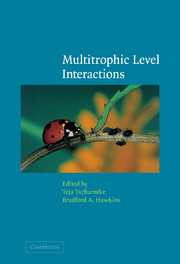Book contents
- Frontmatter
- Contents
- List of contributors
- 1 Multitrophic level interactions: an introduction
- 2 Plant genetic variation in tritrophic interactions
- 3 Multitrophic/multispecies mutualistic interactions: the role of non-mutualists in shaping and mediating mutualisms
- 4 Tritrophic interactions in tropical versus temperate communities
- 5 Endophytic fungi and interactions among host plants, herbivores, and natural enemies
- 6 Multitrophic interactions in space: metacommunity dynamics in fragmented landscapes
- 7 The chemical ecology of plant–caterpillar–parasitoid interactions
- 8 Canopy architecture and multitrophic interactions
- 9 Tritrophic below- and above-ground interactions in succession
- 10 Multitrophic interactions in decomposer food-webs
- Index
3 - Multitrophic/multispecies mutualistic interactions: the role of non-mutualists in shaping and mediating mutualisms
Published online by Cambridge University Press: 08 August 2009
- Frontmatter
- Contents
- List of contributors
- 1 Multitrophic level interactions: an introduction
- 2 Plant genetic variation in tritrophic interactions
- 3 Multitrophic/multispecies mutualistic interactions: the role of non-mutualists in shaping and mediating mutualisms
- 4 Tritrophic interactions in tropical versus temperate communities
- 5 Endophytic fungi and interactions among host plants, herbivores, and natural enemies
- 6 Multitrophic interactions in space: metacommunity dynamics in fragmented landscapes
- 7 The chemical ecology of plant–caterpillar–parasitoid interactions
- 8 Canopy architecture and multitrophic interactions
- 9 Tritrophic below- and above-ground interactions in succession
- 10 Multitrophic interactions in decomposer food-webs
- Index
Summary
Introduction
Off the coast of Massachusetts (USA), the hermit crab Pagurus longicarpus is often found carrying a colonial hydroid, Hydractinia, on its shell. In some situations, this interaction is clearly mutualistic: hermit crabs transport hydroids to rich feeding sites, and hydroids in turn deter larger, damaging organisms from colonizing hermit crab shells. The outcome of this interaction shifts away from mutualism, however, under other ecological conditions. The hydroid tends to be positively associated with a burrowing marine worm that weakens hermit crab shells to the point where they are easily crushed by predatory blue crabs (Callinectes sapidus). The nature of the hermit crab–hydroid association thus varies depending on which other species are present, shifting from mutualism (when blue crabs and/or worms are scarce), to commensalism, to antagonism (Buckley and Ebersole, 1994).
In most introductory biology textbooks, mutualism is defined as an association between organisms of two species in which both species benefit (e.g., Starr and Taggart, 1998; Tobin and Dusheck, 1998; Krogh, 2000). However, the hermit crab–hydroid interaction clearly demonstrates that at least some mutualisms can only be understood within a broader community context. The influence of other species and other trophic levels on mutualism has received curiously little attention, particularly in contrast to other types of interactions (see Barbosa and Letourneau, 1988; Cardé and Bell, 1995; Barbosa and Benrey, 1998; Barbosa and Wratten, 1998; Olff et al., 1999).
- Type
- Chapter
- Information
- Multitrophic Level Interactions , pp. 44 - 66Publisher: Cambridge University PressPrint publication year: 2002
- 37
- Cited by



